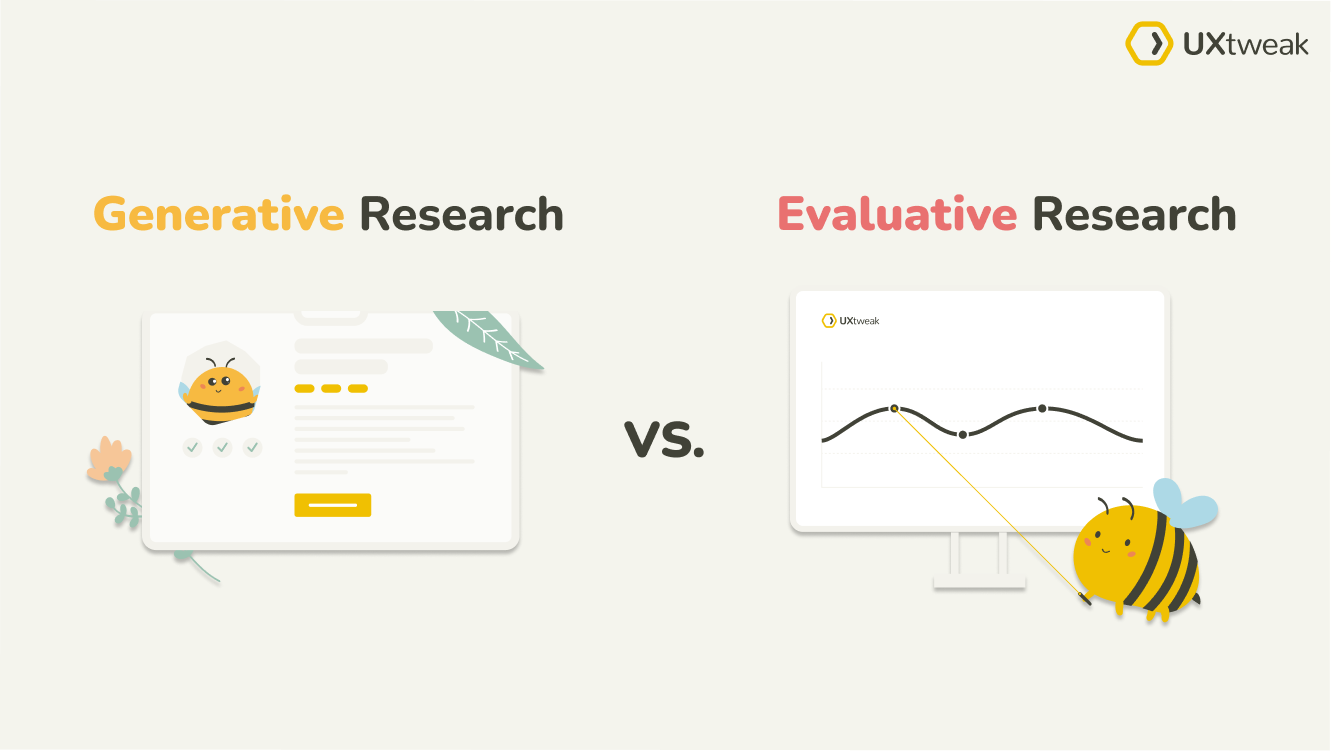There are a lot of different UX research approaches which you can choose from when conducting a research study on your product. While many of them use the same research methods to obtain insights, they all cater to different goals. The same applies to generative and evaluation research.
These two approaches are highly useful when it comes to researching both the product and the users, but are very different in the way they help. Below, we’ll explain everything you need to know about evaluation research and how it’s different from the generative one.
But first, let’s take a look at the definition of evaluation research.
What is evaluation research
Evaluation research (a.k.a. evaluative research) is the type of research used to assess the product’s usability and effectiveness, define how appealing it is to the user and how well it caters their needs.
What is the purpose of evaluation research?
The main goal of evaluation research is to test the overall usability of a product, uncover hidden issues and potential areas of improvement and therefore, improve the user experience. It is a great approach to validating the existing concepts and previously generated ideas.
Evaluative research allows you to find out if the solution you’re creating meets user’s expectations, giving you the opportunity to gather feedback and make informed design decisions.
Evaluation research helps to:
- Gather feedback on your product
- Test usability and improve UX
- Validate concepts
- Make informed improvements
Considering everything mentioned above, evaluative research, when executed at the right time, helps to avoid crucial design mistakes and saves you time and money on future redesigns, allowing to launch an already fine-tuned product.
When to conduct evaluation research
As evaluation research is initially all about validating concepts and looking for things to improve, it’s typically conducted later in the product development process, when you already have a product to validate.

This, however, doesn’t mean you can only conduct evaluative research at the final stage of the development process. The key is to eliminate the issues throughout the way so that you can get a user friendly product at the end. Starting from the early prototyping stages you can gradually validate your concepts and ideas with users, test them and improve as you go.
This can be easily done by implementing different evaluation research methods in your study at the different stages.
For a rough example, let’s say you’re creating a website from scratch. You can start the first round of evaluative research when you already have a design prototype. Here, you can conduct a preference test to find out which design option your target audience likes best. Then, follow up with tree testing to evaluate the information architecture you’ve built for your future website.
At the final stage of prototyping, conduct a prototype test on your designs to see if everything works as intended. Analyze and improve based on the insights obtained. After your site is developed, run a couple rounds of task-based usability testing, before it goes live. This will help to prevent any issues that may occur and give you an opportunity for the last check.
Check out this Evaluation Research Examples to learn how to design a study.
Evaluation research vs. generative research

Generative research (a.k.a. exploratory research) is another method of gathering information about your users. However, it has different goals than the evaluative one and is conducted at different stages of the development process.
The main aim of generative research is to “generate” opportunities for innovation, discover what people’s problems and needs are and what product could solve them. It usually comes before any type of design and development activities and focuses mostly on researching peoples’ background, pain-points and the way they operate.
Later, the information gathered during generative research helps to create a product that solves real problems and caters to real peoples’ needs.
Therefore, the difference between evaluation and generative research is essentially the fact that generative research creates the foundation for the product that’ll be later researched by evaluative research methods.
Survey and Evaluation Research
Surveys are an important tool in evaluation research because they allow researchers to collect data on a wide range of issues. By collecting data before and after the implementation of the program, researchers can assess the impact of the intervention and make informed decisions about future improvements.
What type of evaluation is a survey?
Surveys are a type of evaluation research method used to collect data from individuals or groups on their attitudes, opinions, behaviors, and characteristics. In evaluation research, surveys are frequently used to evaluate the effects or results of a program or intervention on a particular audience or community.
For example, a survey can be used to evaluate the effectiveness of a usability design aimed at keeping users from leaving a website. The survey can address user behavior before and after the redesign, as well as their attitudes toward the website’s usability and awareness of features related to successful navigation.
Focus groups, interviews, case studies, and observational study are some additional forms of evaluative research techniques in addition to surveys. The choice of approach will depend on the research issue, the target audience or demographic, and the available resources. Each of these methods has advantages and disadvantages.
In general, surveys are a useful tool for assessment research because they can provide key details about the attitudes, beliefs, behaviors, and traits of a target audience or group. When created and carried out properly, surveys can offer trustworthy and valid information that can be used to guide decision-making, enhance programs and interventions, and ultimately produce better results for individuals and groups.



